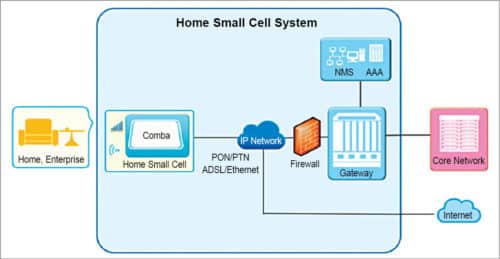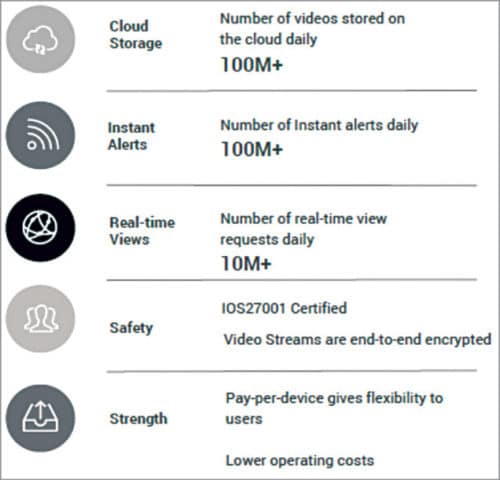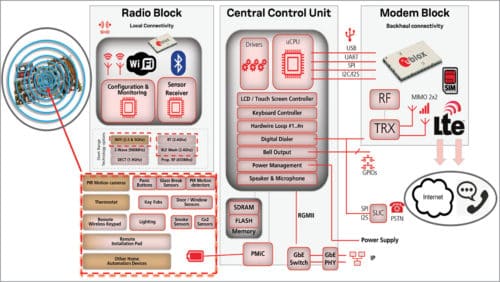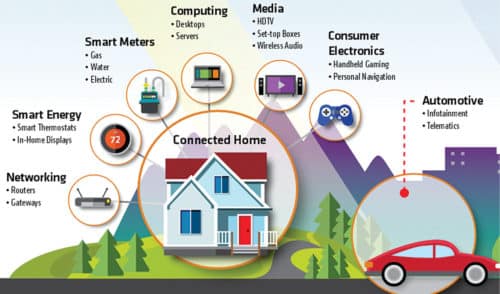A complete wireless networking is an indispensable element of home automation. In this article, we discuss the latest wireless technologies that are making our homes safer and more secure.
Wireless technology for smart homes helps you keep an eye on your home when you are away. You can protect what is valuable to you at home or even manage your business remotely. It provides a safe, convenient and smart life through intelligent devices, cloud-based platforms and advanced technologies.
Innovative wireless technologies including 4G and 5G have paved the way for home automation. Now, you can enjoy home entertainment and remotely protect and take care of your family in a smarter and easier way. The Internet of Things (IoT) enables you to control your appliances, sharing videos or images captured by cameras to friends and families, turning on alarms and sensors, from anywhere. It allows your to do so by way of controlling programmable timing controllers, electrical appliances control systems and more via apps on your smartphone.
Latest technologies for better connectivity
LTE Small Cell technology provides complete, strong in-home wireless network coverage to support the implementation of home automation. It provides cellular indoor coverage via broadband IP backhaul. The technology can solve cellular network issues including weak coverage, low data rate and site acquisition. The solution increases the capacity for data service and offloads macro network by absorbing traffic from indoor hotspots. It gives quality connectivity and, hence, an excellent home automation experience for households.
Marie Ma, senior director of technical marketing solutions and general manager of enterprise business, Comba Telecom, says, “Comba LTE Small Cell solution includes home small cells, gateways and a network management system (NMS). It extends LTE mobile coverage to small, hard-to-reach areas. The solution supports up to eight active users and 24 RRC connected users. It is ideal for small homes and offices, and small public hotspots.” The architecture of LTE Small Cell solution is shown in Fig. 1.

Dhananjay Sharma, chief operating officer, SenRa Tech Pvt Ltd, says, “LoRaWAN as a wireless technology is extensively used in home automation. The application ranges from door/window motion sensing, temperature sensing, carbon monoxide monitoring, water metering, gas metering and more. LoRaWAN gateways with integrated Wi-Fi are already available. This will further augment the use cases for high data rates as well as low data devices and battery-powered sensors.”
Bluetooth Low Energy (BLE) is globally interoperable on 2.4GHz band, and is available on all smartphones and tablets. Recent standard evolutions with Bluetooth 5 as well as BLE Mesh make the technology even more suitable in a smart home. Bluetooth 5 gives double data throughput (2Mbps), which means that communication through an app is faster.
BLE also results in more power-efficient solutions. For example, a battery-driven sensor can send data much faster and then go to sleep, thus saving battery. Bluetooth 5 also increases coverage as the range between devices can be four times that of BLE 4.2, all due to the new BLE long-range coding scheme.
Stefan Berggren, senior product marketing manager – product strategy short range radio, u-blox, says, “Signals can now easily penetrate walls and obstacles in homes, thereby offering a more robust solution. Bluetooth 5 and BLE Mesh technologies are extensively used for making a home smart. Bluetooth Mesh extends coverage and robustness of a home automation system, as data is propagated via node-to-node hops in a mesh network.
“Luminaires, light switches, sensors, thermostats, blinds and air-conditioners can all be connected in a mesh network. A smartphone can also be part of the Bluetooth Mesh network, and an app can easily control lighting and indoor climate systems.
“Solutions for other mesh technologies such as Thread, Zigbee and Wirepas Mesh are also applicable for home automation. Mesh networks in a smart home can be connected to the cloud via a capillary gateway, either using Wi-Fi/Ethernet through the home router or via cellular access.”
Controlling devices wirelessly
Theodore Wang, marketing director – Latin America and India, EZVIZ (smart home security provider, and consumer and residentially focused subsidiary of Hikvision), says, “All smart home products can be connected to apps and cloud platforms. We utilise wireless technologies extensively in IoT-based home automation. Our smart home products, including smart locks, smart doorbells, smart plugs, gas detectors and wireless pet immune PIR detectors support IFTTT, Apple HomeKit, Google Home and Amazon Alexa. These can be connected to EZVIZ app and cloud platform.

“EZVIZ C6C Wi-Fi pan-tilt camera features smart tracking, which upon detection of movement automatically captures and tracks motion while delivering a notification, an image or a video to your smartphone via EZVIZ app in real time. A built-in microphone and speaker enable two-way audio, allowing you to communicate with people on the other side via the app. It also comes with a privacy mode design, allowing you to turn the lens off and enjoy some alone time.”
The company also creates wireless cameras that can deliver features like human detection, human tracking, face detection, face recognition, passenger flow monitoring and smart sound location.
A cellular module is generally present in 90 per cent of modern alarm panels. Depending on system architecture and installation choice, cellular technology can be used as main communication access to alarm receiving centres and to the Internet, or as backup communication when paired with wired or Wi-Fi IP connectivity to the Internet.
Cellular communication is also used in other remote monitoring and alarm systems used in building automation, such as for access control, alert systems for elevators, smoke detectors and domestic healthcare monitoring applications, among others.
Diego Grassi, senior manager – product strategy, for cellular IoT market development, u-blox, says, “Cellular and low-power wide-area (LPWA) chipsets and modules are designed with a unique feature set in terms of security, anti-tampering and energy-efficiency. These address specific needs of IoT use cases including home automation applications.

“LTE Cat 1, Cat M1 and NB1 technologies with modules such as SARA-R4, SARA-N2 and LARA-R3 are now being used or designed in the most innovative home automation systems. Typical applications are residential and commercial security, building surveillance, alarm systems, home automation smart sensors, smoke detectors, actuators, access control and HVAC systems, domestic health monitoring and assisted living.”
John Hamilton, vice president – marketing, RFMW Ltd, says, “We support components designed into IoT devices through Skyworks’ SKY85309-11 front-end module. It is a part of the RF section of an IoT radio. These products allow home-owners greater control over their home environment.

“A host of devices utilise Wi-Fi (IEEE 802.11), Zigbee 802.15.4 and Bluetooth products in smart thermostats, smoke and CO alarms, security system as well as routers, sensors, appliances and door locks, light switches, gaming consoles and televisions.”
Protocols and security features for wireless technology
Comba LTE Small Cell solution follows IPSEC 3GPP TS 36 104 security standards and protocols. Whereas, LoRaWAN follows AES 128 security standards and protocols.
EZVIZ applies the following security standards and protocols for secure control:
- ISO/IEC 27001 certified information security
- Bank-level encryption security
- Encrypting videos and images using user-defined passwords
- Double-encrypting data before saving to cloud servers
- Disabled SSH, Telnet and Web Service
- EZVIZ privacy protocols
Bluetooth Mesh networking is designed with security as its number one priority. It is essential that the software in a connected device is not tampered with. Secure Boot feature provides surety that the firmware is authentic, has not been modified and cannot be downgraded.
u-blox security features are given below.
- 3GPP standardised end-to-end security
- Full two-way manageable channel
- Security based on end-to-end 3GPP encryption
- Data from device to cloud remains unchanged
- Guaranteed quality of service (immunity to interference)
- Device interoperability enabled by open standard protocols
- Facilitate operations with horizontal IoT platforms
- Embedded anti-tampering, lifetime security services
- Integrated secure element
There are many technology platforms and protocols for building a smart home. A smart home protocol must support a large number of devices, as well as offer the best possible device interoperability. Other factors are power consumption, bandwidth and, of course, cost.
Future scope of wireless technologies
The IoT connects things together through the cloud. Home automation is impossible if applications and systems are unable to connect with the network. A complete wireless network is an indispensable element of home automation. Thus, scope of home automation is not only about technologies for the applications, but also technologies for the networking system.
Enhancements in Mesh technologies improve performance and capacity. We are seeing an evolution of end-to-end security in constrained networks. Artificial intelligence (AI) used for human behaviours and patterns monitoring will result in an exponential growth of cellular and short-range technologies in the ecosystem of home automation.







i would like to do a project in this..